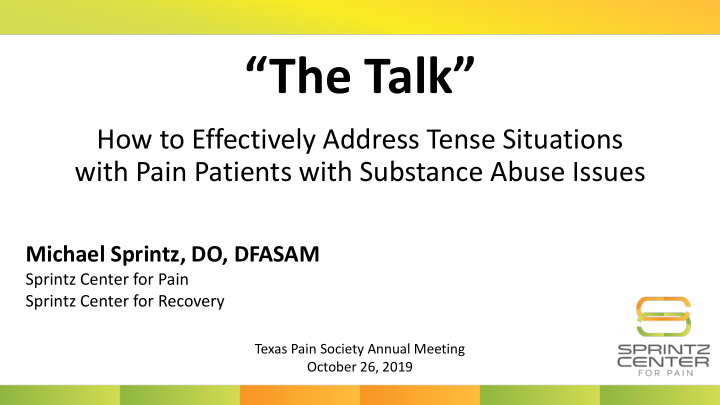



“The Talk” How to Effectively Address Tense Situations with Pain Patients with Substance Abuse Issues Michael Sprintz, DO, DFASAM Sprintz Center for Pain Sprintz Center for Recovery Texas Pain Society Annual Meeting October 26, 2019
Financial Disclosures • Financial Disclosures: ▪ Cellarian, Inc. (Founder and CEO, Board Member) ▪ Cellarian Holdings, (Founder and CEO, Board Member) ▪ Nektar Therapeutics (Consulting- FDA Ad Com) ▪ Heron Therapeutics (Consulting- FDA Ad Com) ▪ SpecGx (Consulting- FDA Ad Com) ▪ Trevena (Consulting- FDA Ad Com) ▪ Flexion Therapeutics (Consulting- FDA Ad Com)
Objectives 1. Describe the challenges to discussing a newly diagnosed substance use disorder in a pain patient 2. Discuss the key techniques used to have a meaningful interaction with a pain patient with a known or suspected SUD 3. Explore options should the patient no longer be a good fit for your practice
Assumptions • We are talking with a patient we know or have a strong suspicion (with objective data) that he/she/they has addiction or substance use disorder • Updated ASAM definition of Addiction https://www.asam.org/resources/definition-of-addiction
ASAM Definition of Addiction (Sept. 2019) • Addiction is a treatable, chronic medical disease involving complex interactions among brain circuits, genetics, the environment, and an individual’s life experiences. • People with addiction use substances or engage in behaviors that become compulsive and often continue despite harmful consequences. • Prevention efforts and treatment approaches for addiction are generally as successful as those for other chronic diseases .
The way most providers feel about talking to their patients about addiction or substance use disorder https://www.wbur.org/cognoscenti/2018/10/23/pops-hitchcock-psycho-ed-siegel Konstantinos Tamvakis/Flickr, CC BY-SA
The way most providers handle discussing substance abuse with their patients https://media.istockphoto.com/photos/head-in-the-sand-picture-id157507641?k=6&m=157507641&s=612x612&w=0&h=gpDPHKmIgXkh5lbJwIQD-kWRoTE0KSNmxsl3cs0-4x8=
Why it’s Hard to Have “The Talk” (i.e. What’s OUR part in this?) 1. Social stigma/bias 2. Negative personal experiences 3. We are healers and we want to help our patients get better 4. Most providers were never formally trained in Addiction Medicine
Why it’s Hard to Have “The Talk” (i.e. What’s OUR part in this?) 5. We want all our patients to do what we tell them, and never lie 6. We want to be liked 7. We want to be right 8. We were never taught how to have healthy confrontations
So, What Do I Do? 1. Have a Plan • Be clear about what you want to do before walking into the room 2. Bring another person in the room with you. • If the patient is of the opposite identified gender, always have a staff member of the same identified gender of the patient in the room with you
So, What Do I Do? 3. Be non-judgmental • This the MOST IMPORTANT factor • Be a PERSON, have empathy 4. Deal with the facts • ex: positive UDT results
So, What Do I Do? 5. Make regular eye contact • Don’t be creepy, Rasputin, but also don’t avoid it 6. Talk slowly and purposefully with a calm tone • Especially if they raise their voice
So, What Do I Do? 7. Recognize manipulation • Single-dad, tears, low-cut v-neck t- shirts, “you’re gonna make me buy oxy’s on the street,” threats, etc …. 8. Don’t negotiate with terrorists • Threats should not be rewarded with a script • Suicide threats- call 911
So, What Do I Do? 9. Set clear, firm boundaries • compassionate but firm 10. Keep those boundaries
What if Things Escalate?
What If Things Start to Escalate? 1. Have a Plan 2. Stay Human • “Recovery” patient ”forced” to buy oxycodone on street 3. Stay Calm • Talk slow → eye contact → ask patient to please lower their voice or you will end the visit immediately
What If Things Start to Escalate? 4. Safety First • The moment you feel unsafe, open the door, step out of the room and ask patient to leave your office. 5. Call for Help • If there is any hesitation or further escalation or argument, call police/911 immediately
How to Discharge a Patient Responsibly 1. Be sure you want to discharge the patient • Consider learning appropriate withdrawal management 2. Try to refer, rather than just discharge. 3. Tell the patient in person. Then send a discharge confirmation letter.
How to Discharge a Patient Responsibly 4. Be aware of your own mental/emotional state (HALT-Ax-Bored). 5. You are not required to give patients pain medication upon discharge • Consider risks vs benefits of doing so • Sometimes it may be appropriate, sometimes not
The Takeaway 1. Have a Plan 6. Talk slowly and purposefully with a calm tone 2. Bring another person in the room with you 7. Recognize manipulation 3. Be non-judgmental 8. Don’t negotiate with terrorists 4. Deal with the facts 9. Set clear, firm boundaries 5. Make regular eye contact 10. Keep those boundaries
Effectively Addressing Substance Use Disorders is Complex Don’t give up hope You may be the only shining light your patient sees
Michael Sprintz , , DO, , DFASAM msprintz@sprintzcenter.com Cell: 614-264-4783 Sprintz Center for Pain/Sprintz Center for Recovery 111 Vision Park Blvd, Suite #100 Shenandoah, Texas 77384
Recommend
More recommend